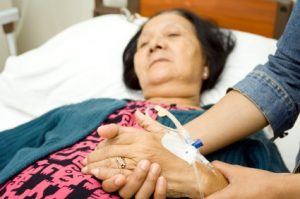Search
Poor Conditions in Nursing Homes Lead to Abuse
 By Hughes & Colman Injury Lawyers
By Hughes & Colman Injury Lawyers
As the population in the US and the world continues to age more and more seniors will be in need of care. Whether in home care providers, family members, or nursing homes most seniors will reach a point where it is no longer safe for them to live on their own and care for themselves. Risk of falling and injury increases as people age. In addition memory problems and Alzheimer’s make it difficult for some seniors to remember how to do the most basic, routine activities. In this case a care solution is required to ensure their continued health and safety.
What if deciding to place our loved ones in a nursing home to get the proper care they need to live comfortably only puts them in more danger? For many seniors this is not a theoretical question but a harsh reality. Abuse in nursing homes is rampant and often times unqualified staff our hired, people are not properly trained, and at times simply do not care. This is not saying that all nursing homes are staffed will untrained, uncaring people – in many cases the opposite is true. Unfortunately for seniors living in a home with staff that does not care – struggling to live alone would be preferable.
It is commonly known in the healthcare industry that individuals should not stay in one position in bed for too many hours. If they do the risk of injury is high and often results in bed sores, a condition that is a common indicator of nursing home neglect and/or abuse. Many nursing home residents struggle to move on their own and in these cases it is the responsibility of the nursing home staff to accommodate these residents. Individuals need to be picked up, moved around, repositioned, bathed, and have their limbs exercised often in order to stay healthy. When they are not – they are at risk for bed sores. There are four stages of bed sores to be aware of:
- Stage One: Soreness, redness, change in skin temperature, and change in color.
- Stage Two: Thickness loss in the top layer of skin, increased pain, appearing like an abrasion or blister.
- Stage Three: Full thickness loss of the skin which can cause death to the surrounding tissue. It will be black around the edges and look like a deep crater.
- Stage Four: The thickness of the skin will be completely lost and the sore very disturbing to look at. In extreme cases it may even reveal bone and connective tissue.
Bed sores are a terrible realty for victims and no individual, elderly or otherwise, should suffer from them due to the neglect of those responsible for their care. Family members should always be aware of the health and condition of loved ones when visiting elderly family members in nursing homes but everyone can help. The Citizens Guide to Preventing & Reporting elder abuse is a valuable resource that aids in recognizing and reporting instances of abuse.
It is important to identify abuse and neglect immediately. Catching bed sores in the first stage so that changes can take place in their routine immediately and prevent them from spreading. Health care providers can easily spot developing sores as long as they take the time to look for them. Those that do not may be held accountable in a court of law. If you or anyone you know has suffered from nursing home neglect or abuse contacting legal representation is a must to ensure that you and your loved ones are protected.
 Nursing Home Law News
Nursing Home Law News

